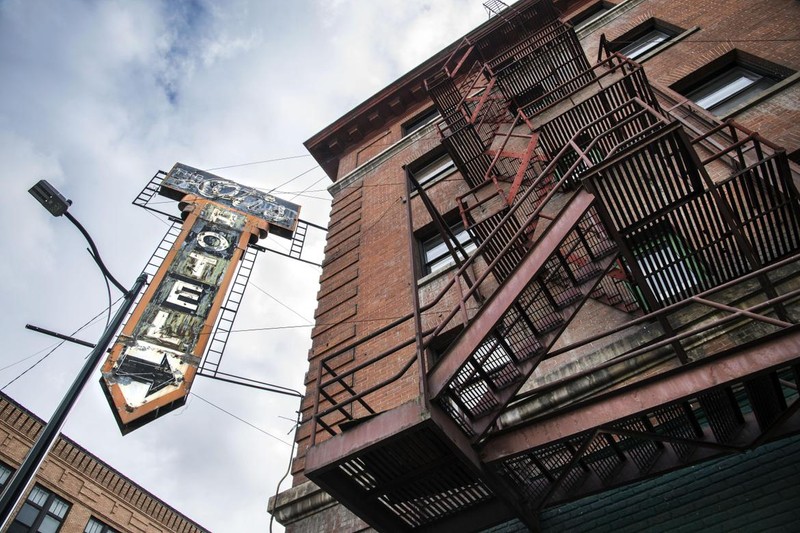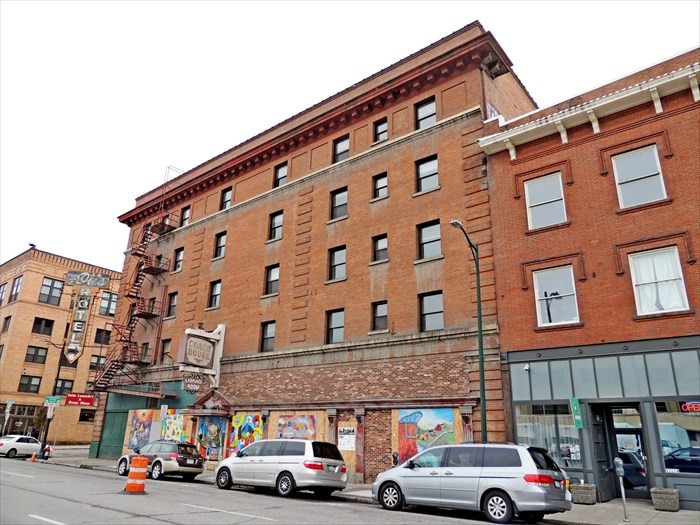Otis Hotel
Introduction
Text-to-speech Audio
Dr. Joseph Gandy arrived to Spokane in 1880 when the town hardly resembled a major city. He spent the next few decades helping guide the city as it benefited from mining, railroads, and the resultant population and economic boom, including financing the Willard Hotel (The Otis Hotel). The single-room-occupancy hotel served Spokane's many migratory workers who arrived in the early twentieth century. The building ultimately stands as a monument to Gandy and Spokane's early, substantial growth.
Images
Source: Spokesman-Review

Source: Waymarking.com, "Otis Hotel - Spokane, WA Image"

Backstory and Context
Text-to-speech Audio
Though Spokane mostly resembled a frontier settlement in 1880, Dr. Joseph E. Gandy chose to make it his home and subsequently grew highly influential in the development of the city, including financing The Otis Hotel in 1911.
Gandy served as the city's first City Council President, and he oversaw the construction of numerous buildings within the eventual Spokane central business district. Much of that development coincided with Spokane's rapid population explosion during the 1880s and again in the early twentieth century, primarily tied to mining and the concurrent influx of railways. Thus, Spokane absorbed many new settlers, including transients and workers, which made single occupancy hotels popular in Spokane such as The Otis.
First known as the Willard Hotel when it opened in 1911, the Otis Hotel catered to the influx of migratory workers who flowed
into Spokane from the 1890s through roughly World War I. The upper floors consisted of approximately forty rooms along with shared bathrooms.
In 1921, Spokane investor and hotelier Victor Dessert purchased the hotel and renamed it the Atlantic, not unlike his already successful Pacific Hotel. Dessert later financed another successful Spokane Hotel, which he simply named the Dessert Hotel.
The Great Depression had a profound effect on the nation, and that changed the role of the hotel. Financial struggles for many resulted in a need for cheap lodging, which begat a trend for the building towards serving the community as low-income housing. By 1941, the Atlantic transitioned to the Milner Hotel; and then it changed to the Earle Hotel in 1948, and finally the Otis Hotel in 1956. By the twenty-first century, The Otis mostly served the elderly and physically challenged before finally falling into disrepair. By 2014, the place had been fenced and vacated, but there's been a recent move in 2017 to renovate the building and turn it into an apartment building.
No matter what function the structure serves, its presence reminds those in Spokane of its early history as a rapidly growing city full of miners, migratory workers, and thousands of new residents. It also exists due to one of Spokane's first residents -- Dr. Joseph E. Gandy --
who helped turn Spokane into a full-fledged metropolis. Gandy died in 1934, having resided in Spokane for forty-seven years, serving as a civic leader, urban planner, medical doctor, and entrepreneur.
Sources
"Coeur d'Alene Mines Corporation History." Funding Universe. Accessed August 25, 2017. http://www.fundinguniverse.com/company-histories/coeur-d-alene-mines-corporation-history/.
Emerson, Stephan. "Nomination Form: Willard Hotel, also the Atlantic, the Milner, the Earle, and The Otis Hotel." National Register of Historic Places. August 25, 1998. https://npgallery.nps.gov/pdfhost/docs/NRHP/Text/98001227.pdf.
Francovich, Eli. "Long abandoned Otis Hotel may be developed as apartment building." Spokesman-Review(Spokane), April 04, 2017.
Stratton, David H, ed. Spokane and the Inland Empire, An Interior Pacific Northwest Anthology.. Pullman, Washington. Washington State University Press,, 1991.
Emerson, Stephan. "Nomination Form: Willard Hotel, also the Atlantic, the Milner, the Earle, and The Otis Hotel." National Register of Historic Places. August 25, 1998. https://npgallery.nps.gov/pdfhost/docs/NRHP/Text/98001227.pdf.
Francovich, Eli. "Long abandoned Otis Hotel may be developed as apartment building." Spokesman-Review(Spokane), April 04, 2017.
Stratton, David H, ed. Spokane and the Inland Empire, An Interior Pacific Northwest Anthology.. Pullman, Washington. Washington State University Press,, 1991.
